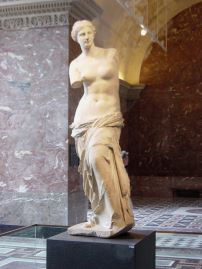Homer's daughter of Zeus and Dione, after whom poet Hesiod emerged from the foam of the sea (hence the foam-borns, Aphrodite Anadyomene = "the one emerging from the sea").
She was the wife of the forge god Hephaistos, whom she betrayed with the war god Ares. Her son of Ares was the god of love Eros (Roman Amor). The death of her lover Adonis caused her great suffering. Through Anchises she became the mother of Aeneas, the later founder of Rome.
Aphrodite is a non-Greek goddess who came to Greece from the Orient by sea. In its form, features of the Semitic goddess of fertility, love and heaven, Astarte, unite with the figure of the Little Asian Mother Goddess; the temple prostitution of the Hieroduls ("holy slaves" in Greek) in the cult of Aphrodite in Corinth and on the Eryx is of oriental origin.
Among the numerous places of worship of Aphrodite, Cyprus - Kypros (hence its nickname Kypris), Kythera (hence its nickname Kythereia) and Mount Eryx in Sicily (hence its nickname Erykine), Latin Erycina) had special significance.
Due to the judgement of Paris, who awarded her the Eris apple as the most beautiful in the dispute with Athena and Hera, the Trojan War ensued.
Myrtle, dove, sparrow and hare were sacred to her. The goddess was often depicted on vases and in sculpture (e.g. Aphrodite Kallipygos = Greek "with the beautiful butt.")
Aphrodite of Melos, better known as Venus of Milo. This statue, 2.04 m high, created in the 2nd century BC, attributed to Phidias or Praxiteles (a re-creation), was found in 1820 at the Greek Empire. Melos Island. It arrived as a gift to Louis XVIII at the Louvre in Paris, where since its arrival in 1821 it has quickly become a gem of the Collection of Classical Antiquities. Replica as reduction.










